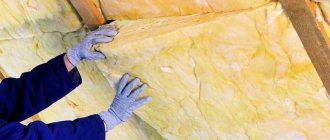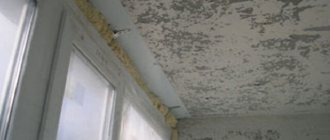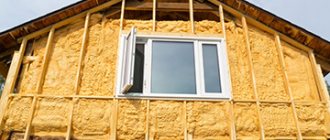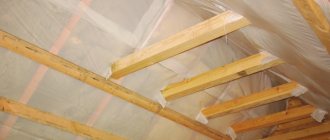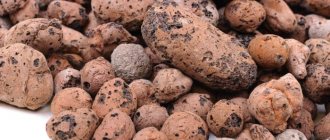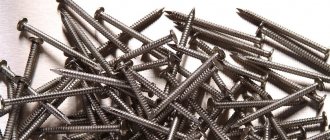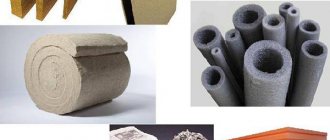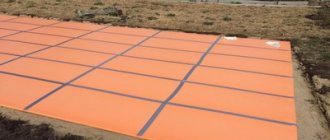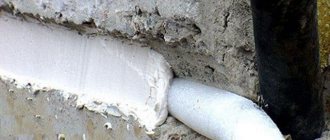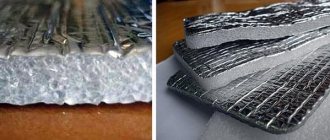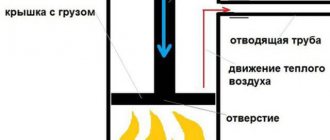Any bathhouse needs high-quality insulation of the ceiling - warm air, according to the laws of physics, tends to rise upward. And if there is no thermal insulation layer along its path, then significantly more fuel will be needed to heat the bathhouse and maintain a consistently high temperature in it.
But this is not the only problem - in the absence of insulation, condensation will accumulate on the ceiling of the bathhouse , and drops dripping from above on the head and back are unlikely to bring much pleasure to anyone. And the moisture that goes up along with the heat will contribute to the destruction of the ceilings and the supporting roof system. The only way to avoid these troubles is to provide high-quality ceiling insulation in a bathhouse with a cold roof. And our material will tell you what and how to make it from.
Why insulate the ceiling in a bathhouse?
Planning work
Before you buy materials and take up tools, you should carefully plan your actions. A clearer understanding of the matter will save you from annoying mistakes and the need to redo everything in the future.
Wooden ceiling insulation scheme
The first question is: is it possible to insulate the ceiling in a bathhouse yourself ? Or should we entrust this matter to a team of builders? The process of insulating the ceiling itself is not something complicated, so it is not difficult to do it yourself, even without much experience in repair and construction. The main thing is to carefully follow the technology and approach the matter responsibly. The availability of the necessary materials also speaks in favor of insulating the ceiling yourself - they can be found in any large hardware store or on the market.
The second question is – what exactly needs to be done ? Insulating the ceiling in a cold bath consists of three stages:
- vapor barrier;
- thermal insulation;
- waterproofing.
The result should be a kind of “layer cake”, the bottom layer of which is the ceiling covering, and above it, vapor barrier, thermal insulation and waterproofing are located sequentially from bottom to top. More details about why this is necessary and how to do it will be discussed below. Now it's time to think about the choice of materials.
Example of a ceiling insulation scheme
Specifics of bathhouse ceiling thermal insulation
Having finally decided on the choice of how to insulate the ceiling in the bathhouse, you can proceed directly to insulation. But first you still need to figure out how to properly insulate the ceiling in a bathhouse. The specificity of bath rooms is such that for high-quality thermal insulation, in addition to the insulation itself, it is necessary to equip two more layers: vapor barrier and waterproofing. These two layers are necessary to protect the thermal insulator from getting wet, thereby maintaining its thermal insulation characteristics and protecting it from mold.
The vapor barrier is always laid on top of the insulation on the side of the bathhouse, and the waterproofing on the roof side. If the bathhouse is built without an attic, then for reliable thermal protection, waterproofing is first installed, and an insulating layer is laid underneath, protected from below by a vapor barrier. If there is an attic in the bathhouse, the arrangement of general insulation is done in the reverse order: first the vapor barrier, then the insulation and on top of it - waterproofing.
For the vapor barrier layer, it is better to choose foil materials. Such a vapor barrier will cost more than a regular one, but the foil layer will not only prevent moisture from reaching the insulation, but will also additionally reflect some of the heat back into the room. Izospan, Folgoplastic and a number of other materials will cope with this task perfectly.
For waterproofing, a dense film of ordinary polyethylene is most often used. If desired, you can also use modern materials, for example, Megaspan - a special membrane that can be used to install both hydro- and vapor barriers.
Selecting insulation
The melted bath maintains a very high temperature and humidity. The thermal insulation material must meet these conditions and, most importantly, not emit harmful substances when heated. In addition, a good insulation for a bath should be fire-resistant. It is undesirable for the thermal insulation material to be too heavy or inconvenient to carry and install. Now let's look at the materials in more detail.
Rules for the installation of multi-layer structures made of lumber
Mineral wool
It is the most common insulation option for baths and private houses; This is a fibrous thermal insulation material that exists in three types:
- glass wool;
- rock wool, which is made from basalt or other rock melts;
- slag wool, made, like cinder blocks, from blast furnace slag.
The main advantage of mineral wool, in addition to its very low thermal conductivity, is that it is not a breeding ground for fungi, mold, insects or rodents. For a bathhouse located on a private plot, this is especially important. It is also worth noting that this material does not burn, does not change its volume and shape when heated or cooled, and is very convenient to install due to its low weight. Mineral wool is produced in the form of rectangular panels or in the form of rolls.
Mineral wool
Mineral wool
Laying mineral wool
Laying mineral wool
As for the disadvantages, there are two of them - the ability of mineral wool to absorb moisture (especially for slag wool) and the potential harm of the phenols contained in them. Both of these disadvantages can be eliminated if you approach the issue of vapor and waterproofing wisely and prevent mineral wool from coming into contact with the air flow, especially inside the bathhouse.
Important! Small particles of mineral wool can have a damaging effect on a person’s eyes, skin or lungs, so when working with it, be sure to wear thick clothing and use gloves, safety glasses and a respirator.
Table. comparative characteristics of different types of mineral wool.
| Type | Fiber length, mm | Fiber thickness, microns | Thermal conductivity, W/(mK) | Flammability |
| Stone wool | 16 | From 4 to 12 | 0,042 | No |
| Glass wool | From 15 to 50 | From 5 to 15 | 0,4 | No |
| Slag | 16 | From 4 to 15 | 0,46 | High temperature sintering |
Expanded clay
They are small pebbles made of clay with a porous structure. Based on the totality of its advantages, expanded clay is the most suitable material for insulating the ceiling in a bathhouse.
- Safety - it does not burn, is environmentally friendly and does not emit harmful substances into the air.
- Durability - expanded clay does not decompose under the influence of sunlight and does not collapse over time.
- This material is not an attractive environment for fungus or bacteria .
- It has low cost and is easy to install.
Expanded clay also absorbs significantly less moisture than mineral wool, but the need for vapor barrier and waterproofing layers still remains.
Expanded clay
Styrofoam
At one time it was one of the leaders among thermal insulation materials. But even taking into account all its advantages, you should not choose polystyrene foam as ceiling insulation in a bathhouse - in the event of a fire, the material burns well, and its smoke is very dangerous to human life and health. It is also capable of decomposing simply under the influence of high temperatures (and they are inevitable in a bathhouse), so polystyrene foam can hardly be called a reasonable choice in this case.
Styrofoam
Ecowool
A natural fibrous material made from cellulose with additives that provide flame resistance and protection against rodents, insects and microorganisms. Ecowool is lightweight and has the ability to fill all cracks and gaps. Like expanded clay, it is environmentally friendly and does not emit any substances harmful to humans into the air.
However, ecowool can absorb a lot of moisture, which impairs its thermal insulation properties. Therefore, when using it, good ventilation under the roof and high-quality waterproofing are desirable. Another disadvantage of its use is the complexity of installation - the “wet” method of application requires special equipment.
“Wet” method of applying ecowool
A mixture of cement and sawdust
It is a “classic” material for insulation, which was used even before mineral wool or polystyrene foam appeared on the market. In some cases, clay can be used instead of cement, and straw instead of sawdust.
First, a dry mixture is prepared in the following proportion: for 10 parts of sawdust, take one part of cement and one of lime. The resulting dry mass should be filled with one and a half parts of water to obtain a fairly thick and homogeneous solution. The mixture is laid out on the surface and distributed in a fairly even layer.
Important! It is advisable to use sawdust that has been dried for several months or better than a year.
This material is very cheap and environmentally friendly, but it does not have such high thermal insulation as expanded clay or mineral wool. In addition, the process of its manufacture is labor-intensive, and after installation it is necessary to repair the resulting cracks (and they are inevitable).
Insulating the ceiling with a mixture of clay and sawdust
Insulating the ceiling in a bathhouse: how?
| Mineral wool (basalt wool) | A product of processing natural stone, it does not burn, does not melt, but crumbles into dust. |
| Ecowool | Non-flammable cellulose, environmentally friendly, with low thermal conductivity, relatively cheap. |
| Foil | This is not insulation, but a reflector of infrared radiation, made of aluminum, and often industrially combined with insulation materials. |
| Expanded clay | A product of firing clay, light and cheap, but it is worth checking the background radiation. It exhibits thermal insulation properties in a layer of 20-30 cm. |
| Expanded vermiculite | Withstands up to 1300 degrees! And thermal conductivity is better than foam. Does not cake during use. A 10 cm layer reduces heat loss by 92% |
| Clay + straw | A popular method of insulation, very cheap, but requiring increased strength of the foundation and walls. |
| Sawdust + dry cement + slaked lime + clay | Cement and slaked lime make sawdust less flammable and repel rodents; clay or sand is added to make it heavier. |
About insulation with clay, sawdust and other folk remedies, see more details here.
Materials for vapor and waterproofing
For a bathhouse, vapor barrier of the ceiling is vital, otherwise rising moisture will not only worsen the thermal insulation properties of the insulation, but will also contribute to the development of fungi and mold on the ceiling itself and on the roof rafters . Specialized films and coatings are used as vapor barrier materials. Particular attention should be paid to anti-condensation membranes. When purchasing vapor barrier films, it is advisable to choose those with a foil layer.
Important! When working with such films, be careful and do not allow any rupture of the vapor barrier material or foil layer, otherwise its protective properties will significantly deteriorate.
As for waterproofing, you can use either special films, which can be found in any hardware store, or cheaper roofing felt or dense polyethylene.
Common vapor barrier materials: 1. Geosynthetics. 2. PVC membrane. 3. Glassine. 4. Tol. 5. Aluminum foil. 6. Thermofol.
Choice of insulation
The first thing you need to do is decide how best to insulate the bathhouse ceiling. You should never take the word of manufacturers who claim that their insulation is the best. When choosing a heat insulator for a bath top, pay attention to the following characteristics:
There is no ideal material for insulating a bathhouse ceiling, but there are a number of materials that meet most of the listed requirements. A good choice would be mineral wool - an insulation that meets most of the listed requirements. The main disadvantage of this material is the sudden loss of thermal insulation properties when wet. And mice can easily make their moves in it. But with high-quality waterproofing, insulating the bathhouse ceiling with mineral wool is considered one of the best options.
Ecowool
Ecowool is a heat-insulating material produced on the basis of cellulose. With all its positive qualities: low thermal conductivity, environmental friendliness, resistance against rodents, fungus and mold, it has a high (up to 20%) water absorption coefficient. For a constantly used bathhouse, this is a very large indicator, but if you heat it once a week, or even two, then you can use ecowool to insulate the ceiling space in the bathhouse.
Izover
Isover is a relatively new insulation material that also has a mineral base. In fact, this is an improved version of glass wool, which has retained its good thermal insulation properties and is devoid of its disadvantages. To insulate the ceiling of a bathhouse, it is better to take an isover equipped with a foil coating for better heat reflection.
The debate about whether it is possible to insulate the ceiling of a bathhouse with foam plastic has been going on for a long time. On the one hand, polystyrene foam has excellent thermal insulation qualities, but on the other hand, over time it begins to disintegrate and release toxic substances.
Expanded clay
Expanded clay is an old, proven material that has been successfully used for insulating bathhouses for a long time. Expanded clay granules made from clay are a good heat insulator and successfully withstand almost all the problems encountered when thermally insulating a bathhouse ceiling. The only “but” is that expanded clay easily absorbs moisture - up to 25% of its mass. If expanded clay is a fairly light material when dry, when wet it becomes heavier and puts pressure on the ceiling. If we are insulating the ceiling of a permanently built bathhouse, then we can use expanded clay, but it is not suitable for insulating light buildings without equipped ceilings.
The same situation applies to available materials: a mixture of clay with sawdust or straw. In the old days, this insulation for bathhouse ceilings was practiced in village bathhouses almost everywhere, but today it is almost never used - there are many problems with it. But, if you need a budget option for thermal insulation, you won’t find it cheaper.
Insulation of a flat ceiling
There are three main types of ceilings in the bathhouse:
- hemmed;
- panel;
- grazing.
Now we will look at the last type and find out how to insulate it and what nuances should be taken into account.
Floor ceilings are usually used for small-sized baths, which are heated quite rarely and seasonally. Tongue or simple edged boards are laid on the upper part of the wall, adjusted to each other and secured, without the use of support beams. The resulting design is very simple, but at the same time it is unable to withstand a large load, therefore it is impossible to use a thick layer of thermal insulation here.
Important! It is advisable to lay the floor ceiling slightly lower than the height of the walls in order to leave space for filling expanded clay or laying mineral wool. If this is not possible, then sides should be nailed along the perimeter of the ceiling under the roof.
The step-by-step insulation of a bathhouse floor ceiling is as follows.
- From the attic side, a vapor barrier film is laid on the flooring so that the foil layer is directed downward. The material should be overlapped by 10-15 centimeters, seams and joints should be sealed with foil tape.
- Mineral wool is laid on top of the vapor barrier, expanded clay is poured, or a mixture of cement and sawdust is laid, depending on your choice. Please note that it is not advisable to use a too thick layer of insulation, since a flat ceiling is not suitable for high loads.
- The heat insulation layer is covered on top with roofing felt, polyethylene film or waterproofing coating, overlapping and carefully gluing the joints.
- The final stage will be laying sheets of plywood or boards on top of the resulting “layer cake”.
Insulation of a flat ceiling with mineral wool
Plywood sheathing
It makes sense to use a flat ceiling in small-sized baths and in cases where the simplicity and speed of its installation and installation of insulation is important to you . If you are planning to make a fairly large steam room or arrange an attic under the roof to store bath accessories, then you should opt for a false ceiling.
Insulation of a suspended ceiling
Here, it is not the flooring itself that is laid on the upper part of the wall, but support beams made from wooden beams or boards spliced together. And the ceiling and floor of the attic are laid on the beams below and above. At the same time, layers of steam, hydro and thermal insulation are laid in the space between them.
Scheme of insulation of a false ceiling
The process of insulating a ceiling with a similar design depends on what material you use. For mineral wool this happens as follows.
- On the roof side, a layer of waterproofing material is laid on the beams and secured using a furniture stapler. To protect from moisture, installation should be carried out with an overlap of 10-15 centimeters.
- Next, plywood or wooden boards are laid on top of the waterproofing. Since the false ceiling is quite strong, the resulting space under the roof can be used as an attic or attic.
- Mineral wool should be placed in the free space between the beams. Its thickness for middle latitudes should be approximately 150-180 mm, and for areas with severe frosts - 200-250 mm. If in a layer of thermal insulation material there are joints between sheets of mineral wool, then the next layer should overlap them.
Insulation of a false ceiling with mineral wool
- A vapor barrier film is attached to the floor beams from below. In this case, it is desirable that its edges bend and overlap the upper part of the walls. Also make sure that when laying the material there is no damage or tearing.
- Wooden slats are attached on top of the vapor barrier perpendicular to the beams.
- The final stage is laying the lining, nailed or screwed to the slats with self-tapping screws.
Video - We insulate the ceiling in a bathhouse with a cold roof using mineral wool
The process of insulating the shed ceiling of a bathhouse with a cold roof looks a little different when expanded clay or a cement-sawdust mixture is used. Let's present this in the form of step-by-step instructions.
Ceiling insulation scheme with expanded clay
- A rough flooring made of boards is laid on the floor beams below. The gaps between them must be treated with sealant or coated with a mixture of clay (or concrete) and sawdust.
- A vapor barrier film is laid on the flooring both from the steam room side and from the roof side, and not only the boardwalk should be covered, but also the beams themselves.
- Expanded clay is poured into the resulting boxes or ecowool is laid.
- Roofing felt or other waterproofing material is laid over the insulation overlapping and secured to the beams using a construction stapler.
- Boards or plywood are laid over the waterproofing to form the attic floor.
- The lining is laid underneath on the rough boards.
Insulation of a false ceiling with expanded clay
If you use a mixture of clay and sawdust to insulate the ceiling, then it is advisable to put a layer of mineral wool on top of the frozen mixture or fill it with expanded clay - this will improve the thermal insulation performance.
Important! The optimal layer thickness of a mixture of clay and sawdust for using a bathhouse in the warm season is 50 mm. If you plan to steam in it in winter, then you will need to make a layer of insulation of at least 150 mm.
The insulation of the bathhouse ceiling also depends on the roof
It was already mentioned above that there are three ways to install a bath ceiling. In fact, there are two of them - the panel one is rarely used. And the rest are distributed between bathhouses with a cold attic, where they usually make a simple and cheap floor ceiling, and bathhouses with an attic, where hemmed technology is used.
The difference between them is, first of all, that the flooring is not intended for walking on it, so they don’t even reinforce it with beams, they simply put boards on the walls, cover them with paper and put a layer of thermal insulation, often the cheapest, but we have already talked about this.
A hemmed one is much more expensive financially. The previous chapter describes it in all details.
Insulation of panel ceiling
This kind of ceiling design is the most difficult to make yourself - first you need to make the panels themselves, and then lift them up and secure them either to cross beams or directly to the top of the walls.
Each of the panels is manufactured as follows.
- A layer of boards, carefully adjusted to each other, is laid perpendicularly on the support bars. This layer will serve as the ceiling for the bathhouse.
- Boards are attached to the inside of the resulting shield, which will serve as the sides of the panel.
- Vapor barrier material is laid on the boards and sides and secured using a construction stapler.
- Mineral wool or ecowool is placed in the interior of each panel. You can also use a cement-sawdust mixture or expanded clay, but in this case the panel will turn out to be especially heavy.
- A polyethylene film or roofing felt is laid on top of the heat-insulating material, with joints overlapping by 5-10 cm.
- The top layer of boards is laid, which will serve as the floor for the attic.
Installation of a panel ceiling in a bathhouse
The resulting panels should be lifted and mounted, and it would not be amiss to lay solid boards on top and bottom of them, connecting all the panels to each other. The joints between them also need to be insulated with strips of mineral wool scraps. As an alternative, you can take the same mixture of cement and sawdust.
Finished panel ceiling
Advice! The assembly of the ceiling panels, their lifting and installation is very labor-intensive. Therefore, it is advisable to use some kind of lifting device and work not alone or in pairs, but as a whole team.
You should choose the type of ceiling and the insulation material used based on your budget, your own experience in construction work, the area of the bathhouse and how often it will be used.
If all recommendations and insulation technology are properly followed, you will receive a high-quality and durable ceiling that will keep heat inside the bathhouse and reduce the consumption of firewood for kindling and maintaining heat in the steam room.
How to insulate a bathhouse ceiling
Insulating the ceiling of a bathhouse is a necessary thing, but very capricious. It is necessary because heated air is lighter than cold air, so a significant part of the heat leaves it through the ceiling. And capricious due to the extreme conditions inside this room, especially in winter. It is no secret that when the bathhouse is heated, the temperature in the steam room can reach 60-70°C, or even higher, and the humidity tends to approach 100%. If it stands unheated for 3-4 days, the temperature in it will be almost the same as outside. Not every heat insulator can cope with such conditions.
